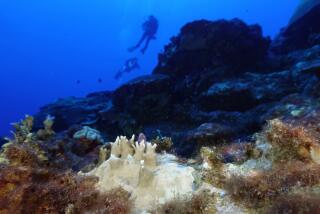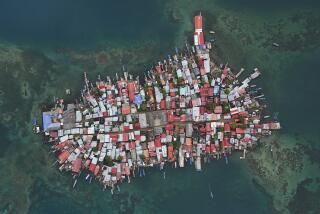Tuvalu’s Sinking Feeling
VAIAKU, Tuvalu — This isolated country is not much more than a few specks in the middle of the Pacific Ocean. Its population wouldn’t fill a fifth of Dodger Stadium. Its highest point is 16 feet above sea level.
But Tuvalu is at the center of international debate over climate change. Many of Tuvalu’s people worry that rising sea levels caused by global warming will wash away their country.
They talk of suing the U.S. government or big American corporations for polluting the atmosphere and causing the planet’s temperature to rise. They condemn President Bush for backing out of the Kyoto Protocol on global warming.
“We don’t have hills or mountains. All we have is coconut trees,” elder statesman Koloa Talake said. “If the industrial countries don’t consider our crisis, our only alternative is to climb up in the coconut trees when the tide rises.”
By all appearances, Tuvalu is a Polynesian paradise. With seven coral atolls and two coral islands, the country is spread across 350 miles of the South Pacific north of New Zealand. Palm trees grow along white sand beaches that fringe the turquoise waters of lagoons.
It remains to be seen whether science will support Tuvalu’s predictions of impending doom, but no one doubts that the country faces a precarious existence.
At the ripe age of 65 million years, its atolls are nearing the end of their geologic life span. Not only do islanders face the danger of the sea rising, they also face the inevitable problem of the land sinking.
Each atoll was formed when a volcanic island sank beneath the sea, leaving a ring of coral islands around a lagoon.
An outer reef protects the land from the pounding of the sea. The coral can grow upward and keep pace with a gradual increase in sea level, but if the ocean rises too quickly, the natural barrier could be lost.
“If the reef is destroyed, it’s goodbye, Tuvalu,” said Wolfgang Scherer, director of Australia’s National Tidal Facility.
The atolls are especially vulnerable to tropical storms that can change the landscape overnight. In 1997, a cyclone swept the topsoil and every tree and bush off the islet of Tepuka Savilivili in Tuvalu’s main atoll, Funafuti.
This former British colony has just 10 square miles of land and a population of 10,400, making it, next to Vatican City, the world’s least populous country.
The Tuvaluans are Polynesians whose ancestors arrived by canoe possibly more than 2,000 years ago. Today they fish, raise pigs and grow taro, cassava, bananas and coconuts on small plots of land.
Most of the jobs are in government. Some men leave Tuvalu to find work as seamen on cargo ships or as unskilled laborers in New Zealand.
Men and women commonly wear flowers in their hair. Many houses have thatched roofs and walls made of woven mats. When the country’s 12-member Parliament is not meeting in the open-sided Maneapa meeting hall, boys play soccer there.
Tuvalu is connected to the outside world only by flights to Fiji twice a week and by occasional cargo ships that bring supplies. Visitors are few. The country has one hotel, which has no hot water.
On Funafuti, television is normally broadcast one evening a week for two hours, although now it is off the air entirely because of an equipment breakdown. A few people, mostly government officials, have computers and can connect to the Internet. There are few cars, and most people get around on foot or by motorbike.
Tuvalu had little contact with the outside world until Spanish explorers arrived in 1781. In the 1800s, slave traders stole hundreds of people from the islands to work the guano mines of Peru. Missionaries converted the rest of the population to Christianity.
Today, many Tuvaluans have a literal faith in the Bible and don’t believe any harm will come from global warming.
Shopkeeper Lutelu Kofe, 46, is typical. He is more concerned about harm to the community from rising alcohol levels than rising water levels.
“I read the Bible, and God said to Noah, ‘No more floods,’ ” Kofe said. “So I’m not worried. When I see the sea, it’s the same as before.”
But the Tuvaluan government is marshaling its arguments in the hope of winning foreign help in finding a new home if the need arises.
Tuvalu has hired an attorney in Washington and is considering whether its best strategy is to sue the U.S. government or American oil companies, coal mining firms and auto makers. But officials acknowledge that pinning the blame for global warming on individual companies would be a long shot.
At one point, Tuvalu asked Australia to agree to accept its entire population in the event the islands are flooded, but Australia refused. New Zealand has agreed to accept 75 Tuvaluans a year, but many islanders can’t afford to make the move.
Nine years ago, scientists from Australia’s National Tidal Facility installed high-tech gauges in Tuvalu and 10 other Pacific nations to measure changes in sea level.
The Tuvalu gauge has detected an average increase of 1 millimeter a year--the same rate at which the oceans have been rising for the last century. “The critical question is whether sea level rise is going to accelerate,” said Scherer, the tidal facility director. “So far, there is no evidence of that happening in Tuvalu or anywhere else around the globe.”
As the Earth’s average temperature has gone up over the last century, glaciers in the Rocky Mountains, the Swiss Alps, the Himalayas and the Andes have receded.
The great fear is that the huge ice sheets of Greenland and Antarctica will melt, drastically increasing the volume of water in the oceans and inundating low-lying coastal areas.
The 1997 Kyoto Protocol was designed to slow global warming by reducing air pollution, particularly carbon dioxide, which many scientists believe creates a greenhouse effect. The Bush administration pulled out of the agreement last year, citing potential harm to the U.S. economy if companies were compelled to cut such emissions.
Fearing for their existence, the low-lying island nations of Kiribati, the Marshall Islands and Nauru in the Pacific and the Maldives in the Indian Ocean have joined Tuvalu in urging the United States to reduce its atmospheric pollution.
“Tuvalu is the first victim of global warming,” said Talake, a former prime minister. “We don’t see any way of avoiding that. The only thing we can do is hope that industrial countries may listen to our poor voice.”
During World War II, U.S. troops landed in Tuvalu to halt the Japanese advance in the Pacific. Their job was to build a landing strip on Fongafale, Funafuti’s main island, and they needed precious dirt. The troops collected soil by digging 10 large holes on the island, some as big as 300 feet long and 50 feet wide.
People here call them “the borrow pits,” but no one has ever returned any dirt. About a third of the island’s arable land was lost to the pits and the runway. Tuvalu has asked Washington for assistance in filling the holes, but the U.S. has declined to help on the grounds that the runway is sufficient compensation.
Today, the 10-foot-deep pits hold water that rises and falls with the tide. Scientists say the flow has accelerated the intrusion of seawater into Fongafale’s aquifer, speeding up the island’s deterioration.
While the islanders criticize industrial countries for emitting carbon dioxide, Tuvalu has its own pollution problem. For years, people have dumped garbage into the borrow pits--everything from beer cans and pig waste to old car bodies and rusting cargo containers.
In February, the time of year when the tides typically are highest, the water in one borrow pit rose to within an inch of flooding the home of third-grade teacher Easter Molu.
“We think maybe next year the water will be inside our house,” said Molu, 27. “Some people don’t want to stay in Tuvalu. They are scared of the sea level. They might drown. They might be eaten by sharks. They worry about their children’s and their grandchildren’s future.”
Flooding inundates places that never used to be underwater, including ancestral graves and the foundations of a building constructed in 1904. Salt water intrudes into gardens, killing crops and ruining the soil. Valuable coastal land is lost to erosion. Some coral in the lagoon is bleached white, possibly because of higher ocean temperatures.
“Americans should look at themselves,” Molu said, “because what they are doing affects other countries, like Tuvalu.”
More to Read
Sign up for Essential California
The most important California stories and recommendations in your inbox every morning.
You may occasionally receive promotional content from the Los Angeles Times.










